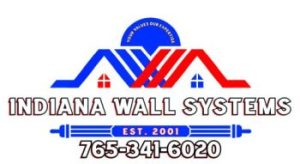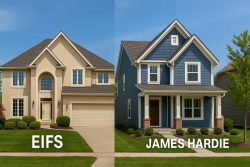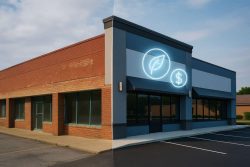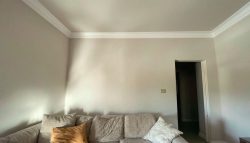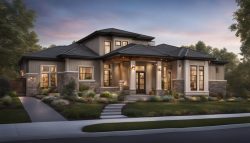Compare Performance, Cost, and Curb Appeal to Choose the Best Exterior for Your Indiana Home
Are you struggling to choose between EIFS and vinyl siding for your Indiana home? You’re not alone.
As a homeowner in the Midwest, you face unique challenges when selecting the right exterior for your property. Our harsh winters, humid summers, and everything in between can really put your home’s exterior to the test.
Hi there! Jeff Johnson here, CEO of Indiana Wall Systems. After 22 years in the EIFS business and working with countless Indiana homeowners, I’ve seen firsthand how the right exterior choice can make all the difference for your home’s protection, efficiency, and curb appeal.
In this comprehensive guide, I’ll break down everything you need to know about EIFS vs. vinyl siding for Indiana homes. We’ll look at costs, durability, energy efficiency, maintenance requirements, and much more to help you make the best decision for your specific situation.
Key Takeaways
- EIFS (Exterior Insulation and Finish System) offers superior insulation with R-values of 4-5.6 per inch compared to vinyl siding’s minimal R-value of 0.61
- Vinyl siding typically costs $4-7 per square foot installed, while EIFS runs $15-30 per square foot but delivers greater long-term energy savings
- EIFS provides better protection against Indiana’s extreme weather conditions and temperature fluctuations
- Vinyl siding requires less maintenance but has a shorter lifespan (20-30 years) versus EIFS (50+ years with proper maintenance)
- EIFS offers unlimited design flexibility and color options compared to vinyl’s more limited aesthetic choices
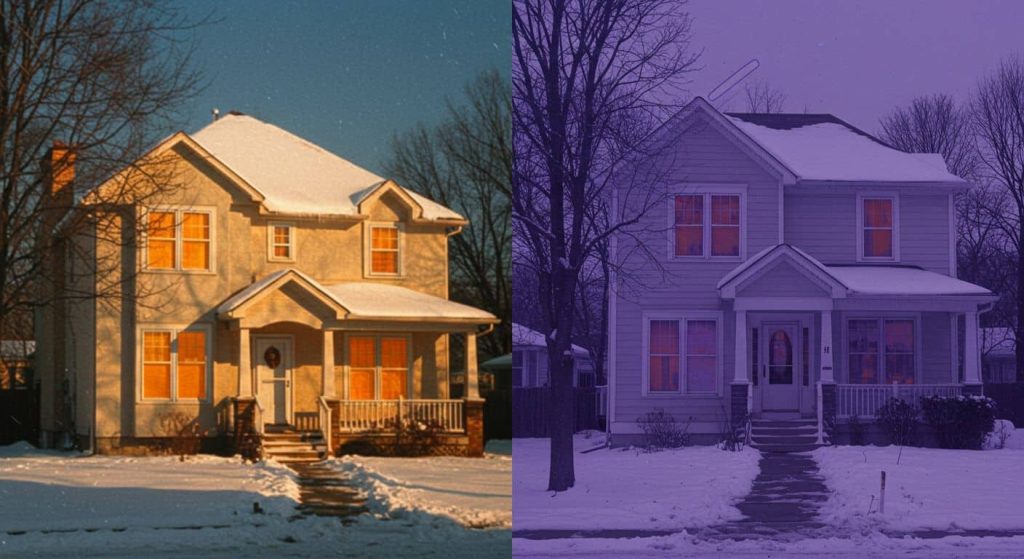
Understanding EIFS: Beyond Basic Stucco
EIFS, or Exterior Insulation and Finish System, is often referred to as synthetic stucco, but that’s an oversimplification. Unlike traditional stucco made from portland cement, sand, and lime, EIFS is a multi-layered wall cladding system designed to insulate and protect your home.
A typical EIFS installation includes:
- An adhesive layer that attaches to your home’s substrate
- Insulation board (usually expanded polystyrene)
- A base coat reinforced with fiberglass mesh
- A finish coat that provides color and texture
What makes EIFS special is how these layers work together to create a complete thermal envelope around your home. This system doesn’t just cover your walls; it actively insulates them.
As someone who’s installed EIFS on everything from small residential repairs to 300,000 square foot commercial units across Indiana, I can tell you that this system offers unique advantages for our local climate.
Vinyl Siding: The Popular Choice
Vinyl siding has become incredibly popular in Indiana neighborhoods, and it’s easy to see why. This siding is made from PVC (polyvinyl chloride) plastic, formed into panels that mimic traditional wood siding patterns.
The appeal of vinyl siding lies in its:
- Affordability: Generally less expensive upfront than many alternatives
- Low maintenance: No painting required, just occasional cleaning
- Wide availability: Offered by many contractors throughout Indiana
- Variety of styles: Available in many colors and textures
Vinyl siding comes in horizontal and vertical patterns, with options like lap siding, Dutch lap, beaded designs, and even panels that imitate cedar shakes or other premium materials.
For many Indiana homeowners, vinyl represents an accessible entry point into home exterior upgrades. But is it the best choice for our specific climate and conditions? Let’s look deeper.
Cost Comparison: Initial Investment vs. Long-Term Value
When comparing EIFS and vinyl siding, many homeowners focus primarily on the initial price tag. Let’s break down the real costs:
| Cost Factor | Vinyl Siding | EIFS |
|---|---|---|
| Initial Installation Cost (per sq ft) | $4 – $7 Average: $5.50 | $15 – $30 Average: $22.50 |
| Maintenance Cost (30 years) | $1 – $2 per sq ft Cleaning, minor repairs | $3 – $5 per sq ft Sealant replacement, recoating |
| Replacement Cost (within 30 years) | $4 – $7 per sq ft One replacement at 20-25 years | $0 No replacement needed |
| Energy Savings (30 years) | $0 – $1 per sq ft Minimal insulation value | $7 – $11 per sq ft 20-30% HVAC energy reduction |
| Net 30-Year Cost (per sq ft) | $9 – $14 Average: $11.00 | $13 – $19 Average: $16.00 |
Note: Cost estimates are based on average Central Indiana prices and typical energy usage patterns. Individual results may vary based on specific home characteristics, installation quality, and energy prices. The 30-year cost analysis shows that while EIFS has a higher upfront cost, significant energy savings and durability benefits reduce the long-term cost differential considerably.
Vinyl Siding Cost Breakdown:
- Materials: $2-5 per square foot
- Installation: $2-3 per square foot
- Total installed cost: $4-7 per square foot
EIFS Cost Breakdown:
- Materials: $8-12 per square foot
- Installation: $7-18 per square foot (labor-intensive)
- Total installed cost: $15-30 per square foot
Based on these numbers alone, vinyl siding is clearly the more budget-friendly option upfront. For a 2,000 square foot home, vinyl might cost $8,000-$14,000, while EIFS could run $30,000-$60,000.
But this is where many homeowners make a crucial mistake. The true cost of your siding extends far beyond installation day.
Long-Term Value Considerations:
Energy Efficiency: EIFS can reduce energy costs by 20-30% annually compared to homes with vinyl siding. For an average Indiana home spending $2,000 on heating and cooling, that’s $400-$600 saved every year.
Lifespan: Vinyl typically lasts 20-30 years, while properly maintained EIFS can last 50+ years. This means you might replace vinyl siding twice during the lifetime of a single EIFS installation.
Home Value: EIFS typically adds more to resale value than vinyl siding due to its premium appearance and energy efficiency benefits.
Maintenance Costs: Vinyl may require replacement of damaged sections, while EIFS might need occasional recoating or repairs to maintain its moisture barrier.
When you factor in these long-term considerations, the initial price gap between EIFS and vinyl narrows significantly. In fact, for many Indiana homeowners, EIFS proves to be the more economical choice over the life of their home.
Durability: Standing Up to Indiana Weather
Indiana’s climate can be particularly challenging for exterior cladding. We face:
- Winter temperatures that regularly drop below freezing
- Summer heat and humidity that can promote mold and mildew
- Dramatic temperature swings in spring and fall
- Occasional severe weather, including high winds and hail
How do EIFS and vinyl siding hold up under these conditions?
Vinyl Siding Durability
Vinyl siding stands up reasonably well to basic weather conditions. Modern vinyl is:
- Resistant to moisture penetration
- Relatively resistant to fading from UV exposure
- Able to withstand moderate winds (up to 110 mph with proper installation)
However, vinyl siding has significant vulnerabilities:
- Brittleness in extreme cold: Vinyl becomes increasingly brittle at temperatures below 20°F, making it susceptible to cracking during Indiana winters.
- Impact damage: Hail or debris can crack or puncture vinyl panels.
- Warping in extreme heat: High temperatures can cause vinyl to warp or buckle.
- Water infiltration at seams: Without proper installation, water can get behind vinyl and cause damage to the underlying structure.
EIFS Durability
EIFS offers superior durability in several key areas:
- Temperature resistance: EIFS remains stable across Indiana’s temperature extremes.
- Impact resistance: Modern EIFS with reinforced base coats provides good resistance to normal impacts.
- Seamless protection: When installed correctly by certified professionals, EIFS creates a continuous barrier without seams where water can penetrate.
- Structural flexibility: EIFS can accommodate minor structural movement without cracking.
The durability advantage of EIFS isn’t just theoretical. In my 22 years of experience with Indiana Wall Systems, I’ve seen EIFS installations remain intact and functional for decades, even on buildings exposed to harsh Midwest weather conditions.
That said, it’s important to note that proper installation is crucial for both systems. Even the best cladding system can fail if installed incorrectly. This is why choosing experienced contractors like our team at Indiana Wall Systems makes all the difference in your cladding’s performance.
Energy Efficiency: The Hidden Cost Saver
Energy efficiency might not be the first thing you think about when choosing siding, but in Indiana’s climate, it should be near the top of your list. Our hot summers and cold winters put heavy demands on heating and cooling systems, and your exterior walls play a huge role in how well your home maintains comfortable temperatures.
Note: R-values shown are typical for Central Indiana installations. EIFS R-value varies based on insulation thickness (typically 1-4 inches). Indiana building codes recommend minimum R-13 for wood-framed walls and R-5 continuous insulation for many applications.
Vinyl Siding’s Insulation Properties
On its own, vinyl siding offers very little insulation value:
- R-value of approximately 0.61 (barely better than nothing)
- Provides minimal thermal barrier
- Seams can allow air infiltration
Some vinyl siding comes with foam backing that improves its insulation properties, typically adding:
- Additional R-1 to R-3 value
- Better rigidity and impact resistance
- Some reduction in thermal bridging
Even with insulated backing, vinyl siding’s total R-value rarely exceeds R-4, which falls short of current energy efficiency recommendations for Indiana’s climate zone.
EIFS Insulation Properties
EIFS is fundamentally an insulation system, with thermal performance as a core benefit:
- R-values of 4-5.6 per inch of insulation thickness
- Typical installations use 1-4 inches of insulation (R-4 to R-22)
- Creates a continuous insulation layer that eliminates thermal bridging
- Wraps around corners and details for complete coverage
This superior insulation translates directly into energy savings. Homes with EIFS typically use:
- 20-30% less energy for heating and cooling than similar homes with vinyl siding
- More stable interior temperatures with fewer drafts
- Less strain on HVAC systems, potentially extending their lifespan
In Indiana’s climate, these energy savings are not trivial. The average homeowner can save hundreds of dollars annually on utility bills, which adds up to significant savings over the lifetime of the cladding.
For a more detailed explanation of how EIFS contributes to energy efficiency, check out our article on how EIFS can slash your energy bills and carbon footprint.
Moisture Control: A Critical Consideration
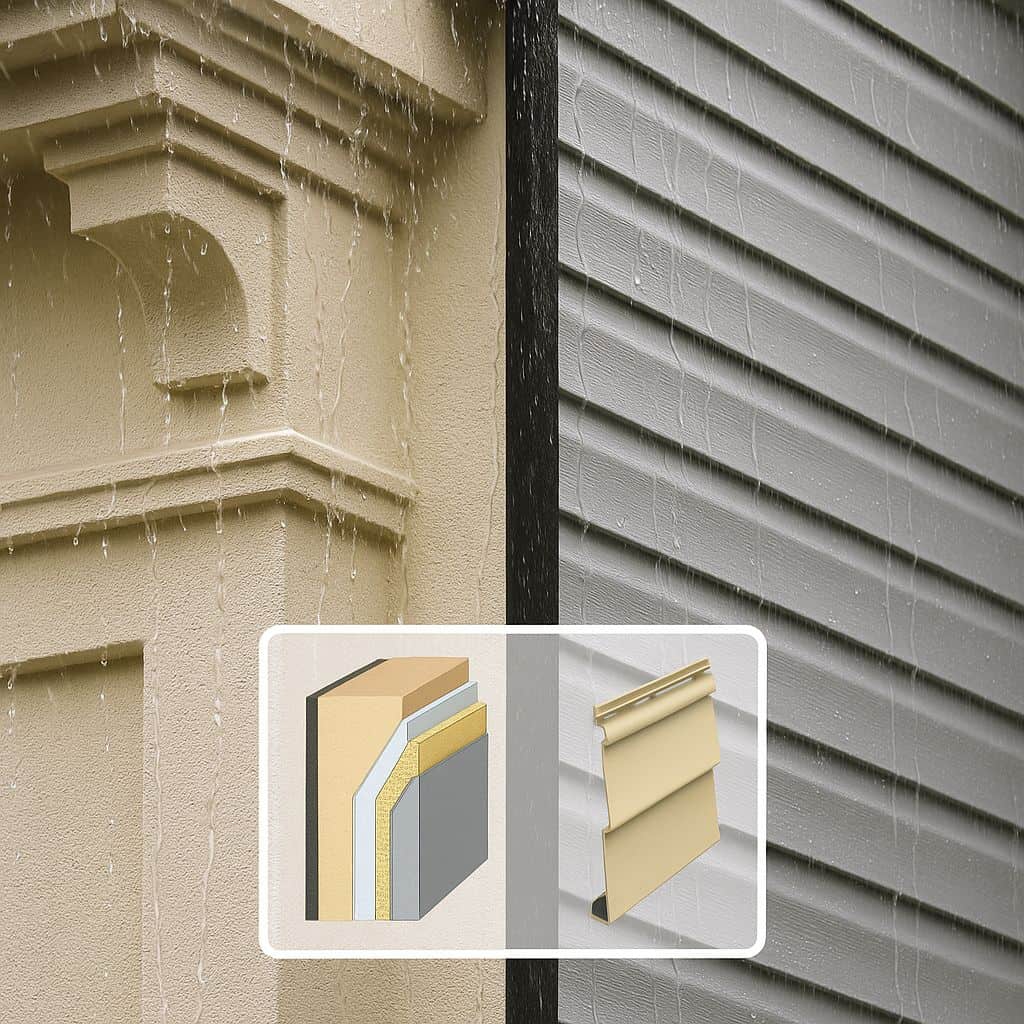
Moisture control is perhaps the most critical factor when evaluating exterior cladding for Indiana homes. Our humid climate creates perfect conditions for moisture problems, which can lead to rot, mold, and structural damage if your siding system doesn’t manage water effectively.
Vinyl Siding and Moisture
Vinyl siding is designed as a rain screen system, meaning:
- It sheds most water away from the home
- It’s not completely waterproof
- It allows some airflow between the siding and wall
- It relies on a weather-resistant barrier (house wrap) beneath it for actual waterproofing
This approach has pros and cons:
Pros:
- Allows walls to “breathe” and dry out
- Prevents trapped moisture between the siding and wall
- Simple drainage path for any water that gets behind the siding
Cons:
- Effectiveness depends heavily on proper installation of the underlying moisture barrier
- Seams can allow water intrusion during heavy driving rain
- Can hide moisture problems until significant damage occurs
EIFS and Moisture
Modern EIFS comes in two main types:
- Barrier EIFS (older systems):
- Creates a complete moisture barrier
- Relies on perfect sealing of all joints and penetrations
- More vulnerable to moisture issues if water gets trapped behind the system
- Water-managed EIFS (modern standard):
- Includes drainage channels behind the insulation
- Incorporates flashing and weep systems
- Provides a pathway for any water that penetrates the system to exit safely
- Includes a water-resistive barrier behind the system
At Indiana Wall Systems, we exclusively install water-managed EIFS systems because they provide superior moisture protection in our local climate.
The Historical Context
It’s worth acknowledging that early EIFS installations (pre-1990s) sometimes developed moisture problems due to barrier-only designs and improper installation techniques. This created some misconceptions about EIFS that persist today.
Modern water-managed EIFS systems, however, have resolved these issues. When properly installed by certified professionals, today’s EIFS provides excellent moisture protection while maintaining its superior insulation properties.
Aesthetic Options: Creating Your Home’s Look
Your home’s exterior isn’t just about protection—it’s about expression. The aesthetic flexibility of your siding choice will determine how your home looks and feels for decades to come.
Vinyl Siding Aesthetics
Vinyl siding offers:
- Wide color selection: Dozens of pre-manufactured colors
- Various profiles: Horizontal lap, Dutch lap, vertical board and batten, etc.
- Texture options: Smooth, wood grain, or rough-sawn appearances
- Decorative accents: Vinyl trim, shutters, and accent pieces
Limitations include:
- Colors are limited to manufacturer offerings
- Texture appears artificial up close
- Uniform appearance that clearly identifies as vinyl
- Limited architectural details
- Seams are visible between panels
EIFS Aesthetics
EIFS provides nearly unlimited design flexibility:
- Thousands of color options with custom tinting available
- Multiple texture finishes from smooth to ultra-rough
- Ability to create architectural details like cornices, arches, and columns
- Custom shapes and patterns can be carved into the insulation layer
- No visible seams (monolithic appearance)
- Can simulate stone, brick, or other premium finishes
- Can incorporate reveals, bands, and other architectural elements
This aesthetic flexibility allows EIFS to complement any architectural style from traditional to ultra-modern. In my work with Indiana Wall Systems, I’ve seen EIFS used to create:
- Elegant traditional details on historic home restorations
- Clean, contemporary lines on modern homes
- Custom decorative elements that would be impossible with other siding materials
- Seamless transitions between different sections of homes
The ability to create custom details and finishes without visible seams gives EIFS a premium appearance that’s difficult to achieve with vinyl siding, regardless of price point.
Installation Requirements and Process
The installation process for both EIFS and vinyl siding varies significantly, impacting not just the initial cost but also the performance and longevity of your exterior cladding.
Vinyl Siding Installation
Vinyl siding installation is relatively straightforward:
- Preparation: Remove existing siding if necessary, repair any damaged sheathing
- Weather barrier: Install house wrap or building paper
- Trim and starter strips: Install J-channels, corner posts, and starter strips
- Panel installation: Hang vinyl panels from bottom to top, allowing for expansion
- Trimming: Cut and fit panels around windows, doors, and other obstacles
- Finishing: Install final trim pieces and accessories
Key considerations:
- Installation typically takes 1-2 weeks for an average home
- Can often be installed over existing siding (though not always recommended)
- Requires proper spacing for expansion and contraction
- Must be installed somewhat loosely to allow for movement
- Quality varies dramatically based on installer skill level
EIFS Installation
EIFS installation is more complex and technical:
- Substrate preparation: Ensure wall sheathing is clean, dry, and structurally sound
- Water-resistive barrier: Apply specialized membrane or fluid-applied barrier
- Drainage provisions: Install drainage mat or channels if using water-managed EIFS
- Accessories installation: Attach starter tracks, weep screeds, and flashings
- Adhesive application: Apply adhesive to insulation boards or substrate
- Insulation board installation: Attach insulation boards with proper joint patterns
- Base coat and mesh: Apply base coat with embedded reinforcing mesh
- Detail work: Create architectural details and proper transitions
- Finish coat application: Apply colored and textured finish coat
- Sealant installation: Apply joint sealants around penetrations and at system terminations
Key considerations:
- Installation typically takes 2-4 weeks for an average home
- Requires specialized skills and proper certification
- Weather conditions during installation are critical
- Curing time between steps must be respected
- Cannot be rushed without compromising quality
The Importance of Professional Installation
While vinyl siding is sometimes marketed as DIY-friendly, both systems benefit enormously from professional installation. This is especially true for EIFS, where proper installation techniques are critical to system performance.
At Indiana Wall Systems, our installation crews have extensive training and certification in all aspects of EIFS installation. This expertise makes a significant difference in how the system performs over time, particularly in managing moisture and maintaining energy efficiency.
Maintenance Requirements: The Ongoing Investment
Maintenance is a critical factor in the long-term cost and performance of any exterior cladding system. Let’s compare what you can expect with each option.
Vinyl Siding Maintenance
Vinyl siding is often promoted as “maintenance-free,” but that’s not entirely accurate. Regular maintenance includes:
Annual or bi-annual cleaning:
- Wash with mild soap and water to remove dirt and mildew
- Pressure washing at low settings can be used (but risks forcing water behind siding)
Periodic inspections for:
- Loose or damaged panels
- Warping or buckling
- Mold or mildew growth
- Damage around penetrations or trim
Repair needs:
- Replacement of cracked or damaged panels
- Reseating of popped nails
- Sealing of gaps that develop over time
- Replacement of damaged J-channels or trim
While these maintenance needs are relatively modest, vinyl siding cannot be painted effectively when colors fade or styles change, meaning the only option for a significant appearance update is complete replacement.
EIFS Maintenance
EIFS requires a different maintenance approach:
Annual inspections for:
- Cracks in the finish coat
- Damage from impacts
- Deterioration of sealants around penetrations
- Water staining or discoloration
- Delamination of layers
Regular maintenance:
- Gentle cleaning with manufacturer-approved cleansers
- Replacement of weathered sealants (typically every 7-10 years)
- Touch-up of damaged areas
- Recoating of the finish layer (typically every 15-25 years)
While EIFS requires more attentive maintenance, it offers a significant advantage: the system can be refreshed and updated without complete replacement. The finish coat can be reapplied in a new color or texture, allowing homeowners to update their home’s appearance relatively economically.
For Indiana homeowners, this maintenance flexibility can be a major advantage. Many of our clients at Indiana Wall Systems have refreshed the look of their homes multiple times over decades while maintaining the underlying EIFS system’s protective and insulating benefits.
For more detailed information on maintaining EIFS, see our guide to best practices for cleaning and maintaining your EIFS.
Longevity and Lifecycle Considerations
How long will your siding choice last on your Indiana home? This question directly impacts the value proposition of each option.
Vinyl Siding Lifespan
Vinyl siding typically lasts:
- 20-30 years for standard vinyl products
- 30-40 years for premium vinyl products
Factors affecting vinyl siding lifespan include:
- Product quality and thickness
- Installation quality
- Local climate conditions
- Maintenance practices
- Sun exposure (UV degradation)
- Physical impacts
In Indiana’s climate, with our freeze-thaw cycles and significant temperature swings, vinyl siding often performs at the lower end of these ranges unless it’s a premium product.
EIFS Lifespan
Properly installed and maintained EIFS can last:
- 30-35 years before requiring significant renovation
- 50+ years for the base system components with proper maintenance and recoating
Factors affecting EIFS lifespan include:
- System design and component quality
- Installation quality
- Maintenance frequency and quality
- Local weather conditions
- Sealant replacement schedule
- Impact exposure
Modern water-managed EIFS systems installed by certified professionals like our team at Indiana Wall Systems regularly exceed these lifespan expectations, especially when homeowners follow recommended maintenance schedules.
End-of-Life Considerations
It’s also worth considering what happens when the siding reaches the end of its useful life:
Vinyl siding:
- Typically requires complete removal and replacement
- Limited recyclability (though improving with newer products)
- Creates significant landfill waste
- Installation process starts from scratch
EIFS:
- Can often be overcoated or renovated rather than replaced
- Base components may remain viable even when finish coat needs replacement
- Offers opportunities for updates and improvements during renovation
- Reduces waste compared to complete replacement
This lifecycle advantage gives EIFS a sustainability edge that’s worth considering alongside its longer lifespan.
Environmental Impact: The Bigger Picture
For environmentally conscious Indiana homeowners, the ecological footprint of their siding choice matters. Let’s compare the environmental credentials of vinyl siding and EIFS.
Vinyl Siding Environmental Considerations
Production impact:
- Made from petroleum-based PVC plastic
- Manufacturing process releases VOCs and other pollutants
- Requires significant energy for production
Usage benefits:
- Minimal maintenance chemicals required
- No need for paint or stains throughout life
- Some products include recycled content
End-of-life issues:
- Not biodegradable
- Limited recycling options (improving but still challenging)
- PVC products in landfills can leach chemicals
- Some older vinyl may contain hazardous additives
EIFS Environmental Considerations
Production impact:
- Components include petroleum-based products (polystyrene, polymers)
- Cement components have high embodied energy
- Manufacturing processes for components vary in impact
Usage benefits:
- Significant energy savings throughout building lifecycle
- Reduced carbon emissions from lower heating/cooling needs
- Durable nature means fewer replacements over time
- Ability to update without complete replacement reduces waste
End-of-life issues:
- Components have varying recyclability
- Polystyrene is technically recyclable but facilities may be limited
- Base coat materials are not easily recyclable
- Overall waste volume can be less than vinyl due to renovation options
The energy efficiency advantage:
The most significant environmental advantage of EIFS is its energy efficiency. Studies show that the energy saved throughout the lifespan of EIFS can offset its production impact many times over.
In Indiana’s climate, a well-installed EIFS system can reduce heating and cooling energy by 20-30% compared to vinyl siding. Over decades, this represents a substantial reduction in carbon footprint that goes beyond the materials themselves.
Special Considerations for Indiana’s Climate
Indiana’s climate presents some specific challenges that should influence your siding decision. Our combination of hot, humid summers, cold winters, and variable spring and fall conditions creates unique demands on exterior cladding.
Temperature Fluctuations
Indiana experiences dramatic temperature swings, both seasonally and sometimes within a single day. These fluctuations cause building materials to expand and contract.
Vinyl siding response:
- Requires special installation techniques with expansion gaps
- May buckle or warp with extreme temperature changes
- Can become brittle and crack in very cold weather
- Rattles or makes noise during temperature changes
- Expansion and contraction may create gaps over time
EIFS response:
- Maintains dimensional stability across temperature ranges
- Insulation layer buffers the substrate from temperature extremes
- Seamless nature accommodates minor structural movement
- Reduces thermal stress on the building structure
- Helps maintain more consistent interior temperatures
Humidity and Moisture
Indiana’s humidity levels can be quite high, particularly in summer months, creating moisture management challenges.
Vinyl siding considerations:
- Allows wall assemblies to breathe, which can be beneficial
- Relies on house wrap for moisture management
- May trap moisture if improperly installed
- Can develop mold or mildew behind panels in certain conditions
EIFS considerations:
- Modern water-managed systems include drainage planes
- Proper flashing details are critical for performance
- Creates a more complete moisture barrier when properly installed
- Reduces condensation issues through superior insulation
- Requires proper integration with other building elements
Storm and Weather Resistance
Indiana faces various weather challenges from thunderstorms to winter ice.
Vinyl siding performance:
- Moderate wind resistance (up to 110 mph with proper installation)
- Vulnerable to impact from hail or debris
- May crack or break during severe winter conditions
- Relatively easy to repair or replace damaged sections
EIFS performance:
- Excellent wind resistance when properly attached
- Modern systems with reinforced base coats offer good impact resistance
- Maintains performance during freeze-thaw cycles
- Can incorporate special reinforcement in high-impact areas
- Repairs to damaged areas blend seamlessly with existing finish
For Indiana homeowners, these climate-specific considerations often make EIFS the more resilient choice, particularly for homes intended to last for generations.
Real-World Performance: What We’ve Seen in Indiana
After 22 years of installing and maintaining both EIFS and vinyl siding systems across Indiana, our team at Indiana Wall Systems has gathered significant real-world performance data. Here’s what we’ve observed in actual Indiana installations:
Vinyl Siding Field Performance
Common issues we’ve seen with vinyl siding in Indiana include:
- Color fading: Particularly on south and west-facing walls, colors typically fade noticeably within 7-10 years
- Storm damage: Hail impacts and wind damage requiring panel replacement
- Moisture issues: Water infiltration at improperly flashed areas causing sheathing damage
- Brittleness: Panels becoming increasingly brittle and prone to cracking after 15+ years
- Aesthetic decline: Visible waviness and distortion developing over time, especially with economy products
That said, quality vinyl siding products installed by experienced professionals do provide:
- Reliable basic protection
- Acceptable performance for many homeowners
- Easy replacement of damaged sections
- Good value for budget-conscious projects or shorter-term housing solutions
EIFS Field Performance
In our experience with EIFS installations throughout Indiana, we’ve observed:
- Thermal performance: Consistent energy savings reported by homeowners, often exceeding predictions
- Longevity: Systems installed 20+ years ago still performing well with proper maintenance
- Weather resistance: Excellent performance during extreme weather events including severe storms
- Aesthetic retention: Colors and textures maintaining their appearance with minimal fading
- Adaptability: Successful integration with various architectural styles across Indiana
The most common EIFS issues we’ve addressed relate to:
- Sealant failures at joints and penetrations (preventable with proper maintenance)
- Impact damage in high-traffic areas
- Water management at roof-wall intersections (typically a design or installation issue)
- Need for recoating after 15-25 years (normal maintenance, not a failure)
Our field experience confirms that while both systems can perform adequately, EIFS consistently delivers superior long-term performance for Indiana homes, particularly regarding energy efficiency, durability, and aesthetic longevity.
Property Value Implications
How will your siding choice affect your home’s value? This consideration is especially important if you might sell your home in the future.
Vinyl Siding and Property Values
Vinyl siding generally:
- Meets minimum market expectations in most neighborhoods
- Provides a neutral impact on home value
- May detract from value in upscale neighborhoods
- Offers limited differentiation from similar homes
- Is seen as a basic, economical choice
From a return-on-investment perspective, vinyl siding typically recoups about 70-75% of its cost at resale.
EIFS and Property Values
EIFS typically:
- Adds premium value in most markets
- Creates distinctive curb appeal
- Signals quality construction and energy efficiency
- Provides a competitive advantage in upscale neighborhoods
- Ages more gracefully than many alternatives
The ROI for EIFS varies based on the neighborhood and market, but generally recoups 75-85% of its cost at resale.
The Appraisal Perspective
From conversations with real estate professionals across Indiana, we’ve learned that:
- Homes with EIFS are often appraised higher than identical homes with vinyl siding
- Energy efficiency features (like EIFS) are increasingly valued by buyers
- Distinctive exteriors help homes sell faster in competitive markets
- Long-term durability is becoming a more important factor for savvy buyers
This value perspective aligns with broader market trends focusing on energy efficiency and sustainability as desirable home features.
Making the Right Choice for Your Indiana Home
With all these factors in mind, how do you decide between EIFS and vinyl siding for your specific situation? Here’s a framework to help you choose:
| Vinyl Siding | EIFS (Exterior Insulation and Finish System) |
|---|---|
| PROS | |
Lower initial cost ($4-7 per sq ft installed) Wide availability of installers in Indiana Minimal maintenance (occasional washing) Quick installation (1-2 weeks typical) DIY-friendly for simple repairs Popular choice in many Indiana neighborhoods | Superior insulation (R-4 to R-16+ depending on thickness) Energy savings of 20-30% on heating and cooling Longer lifespan (50+ years with proper maintenance) Unlimited design flexibility and color options Seamless appearance with no visible joints Excellent for Indiana’s extreme temperature variations |
| CONS | |
Minimal insulation value (R-0.61 standard) Becomes brittle in extreme cold (below 20°F) Vulnerable to impact damage from hail/debris Shorter lifespan (20-30 years typical) Limited design options compared to EIFS May crack during Indiana’s harsh winter freezes | Higher initial cost ($15-30 per sq ft installed) Requires specialized installation expertise More attentive maintenance needed Longer installation time (2-4 weeks typical) Higher repair costs if damaged Excellent for Indiana homes, but requires skilled installers |
| BEST FOR | |
|
|
Based on Indiana Wall Systems’ 22 years of experience with installations throughout Central Indiana. Contact us at (765) 341-6020 for a personalized assessment of your specific home.
Consider EIFS if:
- You plan to stay in your home for 10+ years (to realize energy savings)
- Energy efficiency is a priority for comfort or environmental reasons
- You value distinctive architectural details and custom appearance
- Your home is in an upscale neighborhood where aesthetics matter
- You’re willing to invest in regular maintenance for maximum longevity
- You’re looking for the best long-term value despite higher upfront costs
- Your home has unique architectural features that would benefit from seamless cladding
Consider Vinyl Siding if:
- Initial budget constraints are your primary concern
- You anticipate selling your home within the next 5-7 years
- You’re looking for the simplest, lowest-maintenance option
- Your neighborhood primarily features vinyl-sided homes
- You prefer a traditional lap siding appearance
- You want the ability to easily replace damaged sections yourself
- You’re planning to significantly renovate or expand in the near future
A Hybrid Approach
Many Indiana homeowners opt for a blended approach:
- EIFS on the front facade for curb appeal
- Vinyl siding on less visible elevations for cost savings
- EIFS architectural details combined with other siding materials
- Phased implementation, starting with EIFS on the most weather-exposed areas
At Indiana Wall Systems, we’ve helped many homeowners design these hybrid solutions to maximize value while working within budget constraints.
Installation and Contractor Selection
Regardless of which siding system you choose, the quality of installation will dramatically impact performance. Here’s what to look for when selecting a contractor:
For Vinyl Siding Installation:
- Minimum 5 years of experience with vinyl siding
- Knowledge of proper expansion allowances for Indiana’s climate
- Experience with proper flashing techniques around windows and doors
- Understanding of vapor barriers and house wrap systems
- Ability to properly integrate vinyl with other building elements
- References from local projects
- Written warranty on workmanship
For EIFS Installation:
- Specific EIFS certification and training
- Extensive experience with water-managed EIFS systems
- Knowledge of local building codes related to EIFS
- Proper insurance coverage for EIFS work
- Detailed documentation of system components and maintenance
- Inspection protocol during installation
- Strong references from similar projects
- Comprehensive warranty coverage
At Indiana Wall Systems, our team brings 160 years of combined experience specifically in EIFS installation and repair. This specialized expertise makes a significant difference in system performance and longevity.
Maintenance Tips for Maximum Lifespan
Whatever system you choose, proper maintenance will maximize its lifespan and performance.
Vinyl Siding Maintenance Tips:
- Annual cleaning: Wash with mild detergent and soft brush
- Regular inspections: Check for loose panels, particularly after storms
- Prompt repairs: Address any damaged areas immediately
- Attention to penetrations: Ensure caulking remains intact around fixtures
- Vegetation management: Keep shrubs trimmed away from siding to prevent moisture buildup
EIFS Maintenance Tips:
- Gentle cleaning: Use low-pressure water and approved cleaners
- Annual inspection: Look for any cracks, damage, or sealant failures
- Sealant maintenance: Replace deteriorated sealants at joints and penetrations
- Gutter maintenance: Ensure proper drainage away from EIFS surfaces
- Prompt repairs: Address any damage to prevent water infiltration
- Professional assessment: Schedule professional inspections every 5 years
For more detailed maintenance guidance on EIFS, refer to our comprehensive guide to EIFS maintenance: preserving your investment.
Frequently Asked Questions
Is EIFS really worth the extra cost compared to vinyl siding?
For many Indiana homeowners, yes. When you factor in energy savings, longer lifespan, superior aesthetics, and less frequent replacement, EIFS often delivers better long-term value despite the higher initial investment. The break-even point typically occurs at 12-15 years after installation.
Will vinyl siding protect my home adequately in Indiana’s climate?
Quality vinyl siding, properly installed with good house wrap underneath, will provide adequate basic protection. However, it offers minimal insulation value and may be more vulnerable to extreme weather events. For many homes, it’s a suitable basic option, but not optimal for maximum protection or efficiency.
How often will I need to repaint EIFS?
Unlike traditional stucco, EIFS doesn’t require painting. However, the finish coat may need refreshing after 15-25 years depending on exposure and local conditions. This process is more like recoating than repainting and allows you to change colors or textures if desired.
Can EIFS be installed over existing vinyl siding?
In most cases, yes, though the existing siding usually needs to be removed for best results. We can evaluate your specific situation to determine the best approach for your home.
Is EIFS difficult to repair if damaged?
Minor EIFS repairs are relatively straightforward when performed by experienced professionals. The seamless nature of EIFS allows repairs to blend invisibly with the surrounding area, unlike vinyl siding where replaced panels may not match exactly due to weathering and fading.
Which option is better for historic homes in Indiana?
For historic homes, EIFS offers superior ability to recreate traditional architectural details and profiles. Many historic districts in Indiana allow EIFS when it’s used to faithfully reproduce original design elements, while vinyl siding is often specifically prohibited in historic districts.
How do these options compare in noise reduction?
EIFS provides significantly better sound insulation due to its continuous insulation layer. Vinyl siding offers minimal noise reduction benefits. For homes near highways or in noisy areas, EIFS can contribute to a quieter interior environment.
Making an Informed Decision
Choosing between EIFS and vinyl siding for your Indiana home ultimately comes down to balancing several factors:
- Initial budget constraints vs. long-term value
- Energy efficiency priorities
- Aesthetic preferences
- Maintenance willingness
- Expected length of ownership
- Local climate considerations
- Neighborhood context
Both systems can provide adequate protection for your home, but they excel in different areas. Vinyl siding offers affordability and simplicity, while EIFS delivers superior insulation, durability, and design flexibility.
As the CEO of Indiana Wall Systems with over two decades of experience installing both systems throughout Indiana, I’ve seen firsthand how the right exterior choice transforms homes both aesthetically and functionally. Our team of experts is always available to help you evaluate your specific situation and make the best decision for your home.
Whether you choose vinyl siding for its affordability or EIFS for its performance advantages, proper installation and maintenance remain the keys to success. Working with experienced, certified professionals will ensure that whichever system you select will protect your Indiana home for years to come.
Ready to explore your options further? Contact Indiana Wall Systems at (765) 341-6020 for a FREE consultation and estimate. We’ll help you navigate these choices and find the perfect exterior solution for your Indiana home.
